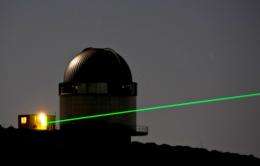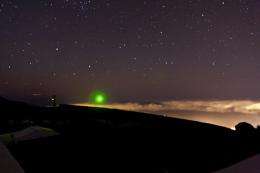Star Wars laser offers new insight into Earth's atmosphere

With the need to understand global change one of today’s most pressing scientific challenges, ESA is exploring novel techniques for future space missions. Firing laser pulses between satellites is promising a step up in tracking greenhouse gases.
More renowned for their appeal as holiday destinations, the Spanish Canary Islands recently played host to an experiment that involved shooting laser beams from a peak on La Palma to Tenerife.
Over the course of two weeks, the night sky lit up with green pulses of light between the two islands – looking more like a scene from a Star Wars film than an experiment to help understand Earth’s atmosphere.
The experiment was devised to test the concept of using ‘infrared differential absorption spectroscopy’ as a way of making extremely accurate measurements of trace gases such as carbon dioxide and methane.
The approach links two satellites orbiting Earth: one acts as a transmitter and the other acts as a receiver, with the atmosphere being probed as the beam travels between them.
Radio occultation involves tracking signals from satellites as they rise or set behind Earth and is a well-established method of sensing the atmosphere using microwave signals.
This new concept, however, uses shortwave infrared laser pulses.
At the right wavelength, the atmospheric molecules affect the beam. This information can then be used to calculate concentrations of trace gases, and potentially wind.
Repeated at different altitudes, a vertical profile stretching from the lower stratosphere to the upper troposphere could be built up.
As an important part any new development, the theory has to be put to the test.
The equipment was placed on the two islands, taking advantage of ESA’s optical ground station on Tenerife. This facility, built on a peak 2390 m above sea level, is part of a larger astronomical installation called the Observatorio del Teide run by the Instituto de Astrofisica de Canarias (IAC).

The station offered the perfect location to install the receiver hardware, which was integrated into the main telescope. IAC runs another facility, the Observatorio del Roque de los Muchachos, on top of a similarly high peak on La Palma.
Perched on these volcanic mountains and separated by 144 km of Atlantic Ocean, there is an unobstructed path between the two facilities, making them one of the best sites in the world to conduct such experiments.
During the two weeks, the core team of scientists from the Wegener Center of the University of Graz in Austria and the Universities of York and Manchester in the UK recorded the first data of this kind.
The infrared beam is invisible to the naked eye, but the impressive green guidance laser was used to record atmospheric turbulence alongside the infrared laser.
Gottfried Kirchengast from the Wegener Center said, “The campaign has been a crucial next step towards realising infrared-laser occultation observations from space.
“We are excited that this pioneering inter-island demonstration for measuring carbon dioxide and methane was successful.”
Armin Löscher from ESA’s Future Mission Division added, “It was a challenging experiment to coordinate, but a real pleasure to work with the motivated teams of renowned scientists and young academics.”
The experiment was carried out within ESA’s Earth Observation Support to Science Element.
Provided by European Space Agency


















